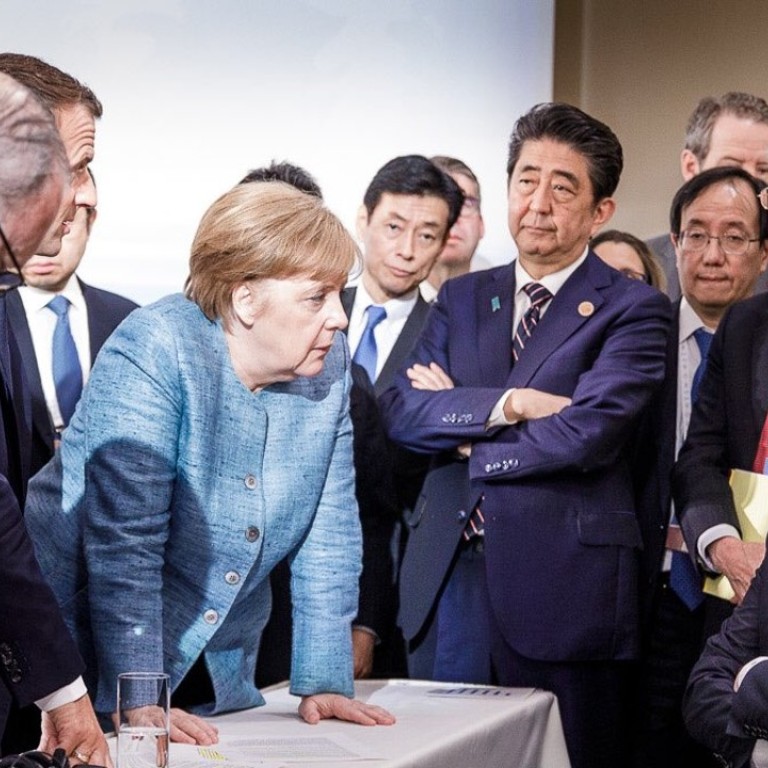
The writing on the wall shows world’s biggest markets coming together to push back against Trump’s trade war
- Japan’s prime minister Shinzo Abe has recently concluded two important trade deals, neither including the US
- Trump does not seem to understand that, important and huge as the US market is, many other growing markets are forming alliances in which a belligerent, trade war-wielding America isn’t welcomed
Donald Trump continues to bang the drum of trade wars with China and others, but he may achieve only a Pyrrhic victory as he pushes the global economy toward an increasingly likely economic slowdown, or even recession.
The US could also be left standing alone as he drives the main targets of his attack into new alliances.
Signs of trouble continue to grow, amid slowing economic growth in China, Japan and elsewhere, partly due to trade friction, and partly due to reduced demand across a swathe of the global economy. All this is being reflected in wobbly financial markets.
He could well find himself breaking down tariff barriers in trading partner countries whose demand for goods is meanwhile being blighted by a global slowdown of his own making. It is hard to see how this could possibly make America great again - unless it is by offering financial bailouts to other economies.
But it is in the longer term implications of trade wars that Trump and his more hawkish economic aides are being dangerously short sighted and are risking a diminution rather than an enlargement of US economic power. They appear to be blind to fundamental trade shifts that are taking place across Asia.
The US president himself helped precipitate these shifts when he pulled the US abruptly out of the Trans-Pacific Partnership (TPP) at the beginning of 2017. They have since taken on a life of their own as Trump trade wars create a climate of uncertainty about the reliability of the US as a trading partner.
Japan’s prime minister Shinzo Abe managed recently to create the world’s largest bilateral free trade agreement with the European Union, and closed a key deal with the renamed Comprehensive and Progressive Trans-Pacific Partnership (CPTPP). Both will take effect in coming months and neither includes the US.
Japan is also involved in negotiations on a Regional Comprehensive Economic Partnership (RCEP) agreement which would include China, India, Australia, New Zealand, South Korea and the 10 members of Asean; again without the US. The RCEP is taking longer to conclude than the CPTPP, but it signals the direction for the future.
The Trump administration does not seem to understand that, important and huge as the US market is, there are many other growing markets that are forming alliances in which a belligerent, trade war-wielding America can hardly be expected to be welcomed.
America’s imports are valued at US$2.3 trillion in 2017, making it the world’s single biggest market. The European Union’s import market is US$1.9 trillion, China is at US$1.7 trillion. Japan’s market is no minnow at US$625 billion and neither is South Korea’s at US$4567 billion.
If bilateralism is Trump’s preferred form of trade relationship, that does not appear to be the case with the rest of the world where plurilateralism is the option of choice, as shown by the Asia-Pacific region.
The Japan-EU agreement signed in August was admittedly hastened by Trump’s tariff threat on Japanese and EU exports, including those of the critical automobile sector.But even if trade wars were to be called off, the pact between the two blocs accounting for a quarter of global GDP is here to stay.
The Japan-EU deal gives Abe leverage in the negotiations that are being forced upon Japan by Trump to enter a bilateral FTA with the US. Japan has also acquired leverage by successfully concluding the talks with the CPTPP, whose 11 members make up nearly 14 per cent of global GDP.
China is the country most in danger of losing out, at least in the short term, to Abe’s trade initiatives, and in the Trump trade wars. Unless Beijing makes concessions on tariffs levied against imports of US vehicles, Trump will be likely to step up the pressure on China. The question then is where does China turn for help?
China could apply to join the CPTPP to offset the impact of Trump’s trade wars but it would have to be on Japan’s terms as leader of the group.
Conversely, Japan might see the wisdom of pushing for the early conclusion of an RCEP pact that includes the world’s second biggest economy - China’s.
An RCEP with both China and Japan would account for 30 per cent of global GDP and 25 per cent of global exports. That size could scare even Donald Trump into backing down.
But in any event, the writing is on the wall for Trump; it says that formidable forces are ganging up against him.
Anthony Rowley is a veteran journalist specialising in Asian economic and financial affairs

